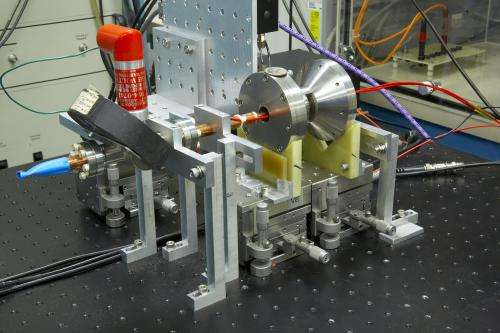New vacuum power amplifier demonstrated at 0.85 Terahertz

The submillimeter wave, or terahertz, part of the electromagnetic spectrum falls between the frequencies of 0.3 and 3 terahertz, between microwaves and infrared light. Historically, device physics has prevented traditional solid state electronics (microchips) from operating at the terahertz scale. Unlocking this band 's potential may benefit military applications such as high data rate communications, improved radar and unique methods of spectroscopy—imaging techniques that provide better tools for scientific research. However, access to these applications is limited due to physics.
Researchers under DARPA 's Terahertz Electronics (THz) program have designed and demonstrated a 0.85 Terahertz power amplifier using a micromachined vacuum tube—a world 's first. The achievement comes from DARPA-funded researchers at Northrop Grumman Electronic Systems, who built the 1 centimeter-wide traveling wave vacuum tube. The vacuum tube power amplifier is only one achievement of the broader THz program, which seeks to develop a variety of breakthrough component and integration technologies necessary to one day build complex THz circuits for communications and sensing.
"Vacuum tubes bring back visions of antique electronics, but these are not your grandparents' TV sets" said Dev Palmer, DARPA program manager. "DARPA-sponsored research has taken tools developed by the semiconductor and MEMS revolution—microfabrication methods and materials—and applied them to reliable, efficient vacuum tube technologies. This mix of old and new gives us a never-before-achieved terahertz-class vacuum power amplifier."
As solid-state and vacuum electronics approach the terahertz band, laser-based technologies are approaching from the other end of the spectrum. Unlike lasers, the electronics produced under THz would be able to handle multiple missions with a single system. For applications like ultra-high data rate digital communications, these technologies could enable wireless networks exceeding 100 gigabits per second—orders of magnitude faster than today 's networks.
Other applications include plans to insert the THz-class amplifier into a demonstration of DARPA 's Video Synthetic Aperture Radar (ViSAR). ViSAR seeks to build a sensor system for aerial platforms that peers through clouds to provide high-resolution, full-motion video for engaging moving ground targets in all weather conditions.
"Further research and development in this field will help unlock applications for our military in this historically difficult to access part of the spectrum," said Palmer.
Provided by DARPA

















